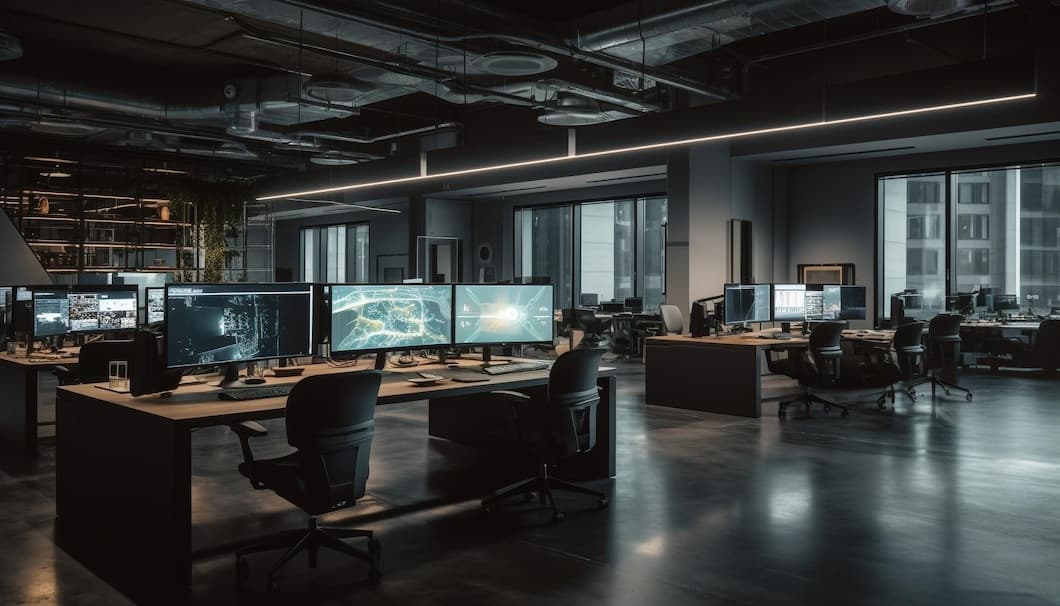What Is The Best Keyboard For A Home Office Setup?

When setting up a home office, choosing the right keyboard is essential for both comfort and productivity. There are many different types of keyboards available, each with its own unique features and benefits. In this article, we will discuss the different factors to consider when choosing a keyboard for a home office setup, and we will provide some recommendations for the best keyboards on the market.
One of the most important factors to consider when choosing a keyboard is the type of switch used. There are three main types of switches: membrane, scissor-switch, and mechanical. Membrane switches are the most common type of switch, and they are typically found on budget keyboards. They are quiet and have a low profile, but they can also be mushy and unresponsive. Scissor-switch keyboards are a step up from membrane keyboards, and they offer a more tactile typing experience. They are also quieter than mechanical keyboards, but they are not as durable. Mechanical keyboards are the most expensive type of switch, but they also offer the best typing experience. They are durable, responsive, and tactile.
Comfort and Ergonomics
Comfort and ergonomics are essential considerations when choosing a keyboard for your home office setup. Extended typing sessions can lead to discomfort and even injuries if your keyboard is not designed with these factors in mind. Look for a keyboard that provides proper wrist support, comfortable key spacing, and a responsive typing experience.
Consider the type of typing you do most often. If you spend a lot of time typing documents, you may want a keyboard with a traditional layout. If you frequently enter data or work with spreadsheets, a numeric keypad may be beneficial. Adjustable keyboards allow you to customize the angle and height of the keyboard for optimal comfort.
The material and construction of the keyboard also impact comfort and ergonomics. Soft-touch keys can reduce finger strain, while a durable build ensures longevity. Additionally, consider keyboards with programmable keys or macros to streamline your workflow and reduce repetitive motions.
Finally, personal preferences also play a role in choosing the best keyboard for your home office. Some individuals prefer a tactile typing experience with audible key clicks, while others opt for a quieter, more subdued feel. Experiment with different keyboards to find the one that suits your unique needs and preferences.
Build Quality and Durability

Size and Layout
Size and Layout
The size and layout of your keyboard are important considerations for your home office setup. If you have a small desk, you'll want a compact keyboard that doesn't take up too much space. If you have a lot of desk space, you may prefer a larger keyboard with a more ergonomic layout.
There are two main types of keyboard layouts: standard and ergonomic. Standard keyboards have the keys arranged in straight rows, while ergonomic keyboards have the keys arranged in a curved shape to fit the natural contours of your hands.
If you spend a lot of time typing, an ergonomic keyboard can help to reduce wrist strain and improve your overall comfort. However, ergonomic keyboards can be more expensive than standard keyboards, so it's important to weigh the pros and cons before making a decision.
Key Travel and Responsiveness

Key travel, or the distance a key moves when pressed, is an important factor to consider when choosing a keyboard for a home office setup. A keyboard with a higher key travel will have a more responsive feel, making it easier to type quickly and accurately. Responsiveness is also important for gaming, as it can help you to react more quickly to on-screen events.
The best keyboard for a home office setup will have a key travel of at least 1.5mm, and a responsiveness of at least 50ms. Key travel and responsiveness are two of the most important factors to consider when choosing a keyboard, so it's worth taking the time to find a keyboard that meets your needs.
Backlighting and Aesthetics
Backlighting is a great way to add some personality to your keyboard, and it can also be helpful for working in low-light conditions. However, there are a few things to keep in mind when choosing a keyboard with backlighting.
First, consider the type of backlighting you want. There are two main types of backlighting: single-zone and multi-zone. Single-zone backlighting illuminates the entire keyboard evenly, while multi-zone backlighting allows you to control the lighting in different zones of the keyboard.
Another thing to consider is the brightness of the backlighting. If you're planning on using your keyboard in a well-lit room, you may not need very bright backlighting. However, if you're planning on using your keyboard in a dark room, you'll want to make sure the backlighting is bright enough to see the keys.
Finally, consider the aesthetics of the keyboard. Backlighting can be a great way to add some style to your keyboard, but it's important to choose a keyboard with backlighting that complements your personal style.
Wired vs. Wireless

Numpad: Yes or No?

Additional Features
Additional features can include programable keys, volume controls, and macro recording. Programmable keys can be assigned to perform specific tasks or macros, which can save time and increase efficiency. Volume controls allow you to quickly adjust the volume of your audio without having to fumble with your computer's settings. Macro recording allows you to record a series of keystrokes and then assign them to a single key, which can be useful for automating repetitive tasks.
Some keyboards also come with additional features such as backlighting, which can be helpful for working in low-light conditions. Others may have built-in USB ports, which can be convenient for connecting external devices such as a mouse or flash drive. When choosing a keyboard, it's important to consider the features that are most important to you and your workflow.
Ultimately, the best keyboard for a home office setup is one that meets your individual needs and preferences. Consider factors such as ergonomics, functionality, and additional features when making your decision. By taking the time to find the right keyboard, you can improve your productivity and comfort while working from home.
Mchanical vs. Membrane
Mechanical keyboards are known for their durability and responsiveness, making them a popular choice for gamers and typists. They offer a tactile feel and a satisfying clicky sound when pressed, which some users find more enjoyable to type on. However, mechanical keyboards can be more expensive than membrane keyboards and they can be louder, which may not be ideal for use in a quiet office environment.
Membrane keyboards are less expensive than mechanical keyboards and they are generally quieter. They offer a softer, more cushioned feel when pressed, which some users may find more comfortable for long typing sessions. However, membrane keyboards are not as durable as mechanical keyboards and they may not provide the same level of responsiveness or tactile feedback.
Ultimately, the best keyboard for a home office setup depends on your individual preferences and needs. If you are looking for a durable and responsive keyboard with a tactile feel, then a mechanical keyboard may be a good option for you. If you are looking for a less expensive and quieter keyboard, then a membrane keyboard may be a better choice.
Here is a table summarizing the key differences between mechanical and membrane keyboards:
Gaming Keyboards for Home Offices?
Gaming keyboards are not typically recommended for home offices. They are designed for gaming, and their features, such as backlighting and programmable keys, are not necessary for office work. Additionally, gaming keyboards can be more expensive than regular keyboards. If you are looking for a keyboard for your home office, it is best to choose one that is designed for productivity, such as an ergonomic keyboard.
If you do decide to get a gaming keyboard for your home office, there are a few things to keep in mind. First, make sure that the keyboard is comfortable to use. You will be spending a lot of time typing, so you want to make sure that the keyboard is not going to cause you any pain or discomfort. Second, consider the features that you need. If you only need a basic keyboard, then there is no need to spend extra money on a gaming keyboard with a lot of bells and whistles. Finally, make sure that the keyboard is compatible with your computer.
Frequently Asked Questions
What features should I look for in a keyboard for a home office?
When choosing a keyboard for a home office setup, there are several key features to consider. These include the type of keyswitch, the layout of the keyboard, the presence of a number pad, and the level of backlighting. The best keyboard for your home office will depend on your individual needs and preferences.
What is the difference between a membrane keyboard and a mechanical keyboard?
Membrane keyboards are the most common type of keyboard. They use a thin sheet of rubber or silicone to register keystrokes. Mechanical keyboards, on the other hand, use individual switches for each key. This gives them a more tactile feel and makes them more durable. Mechanical keyboards are also more expensive than membrane keyboards.
What are the different types of keyswitches?
There are three main types of keyswitches: linear, tactile, and clicky. Linear switches have a smooth, consistent feel. Tactile switches have a slight bump when you press them, which gives you feedback that you have registered the keystroke. Clicky switches have a more pronounced bump and a clicking sound when you press them.
What is the best layout for a home office keyboard?
The best layout for a home office keyboard will depend on your individual needs and preferences. However, some of the most popular layouts include the QWERTY layout, the Dvorak layout, and the Colemak layout. The QWERTY layout is the most common layout, but the Dvorak and Colemak layouts are designed to be more ergonomic and efficient.
Summary
When choosing a keyboard for your home office setup, there are several factors to consider, including the type of work you do, your budget, and your personal preferences. If you're a writer or programmer, you'll want a keyboard with a comfortable typing experience and plenty of function keys. If you're on a budget, there are several affordable options available. And if you have specific preferences, such as a preference for a certain type of key switch or a certain layout, there are keyboards available to meet your needs.
Ultimately, the best keyboard for your home office setup is the one that meets your individual needs and preferences. By considering the factors discussed above, you can choose a keyboard that will help you be more productive and comfortable while working from home.




